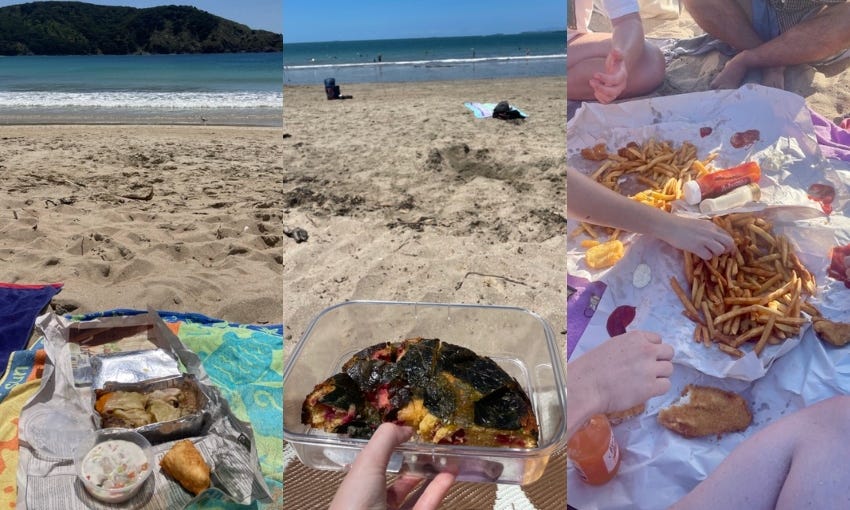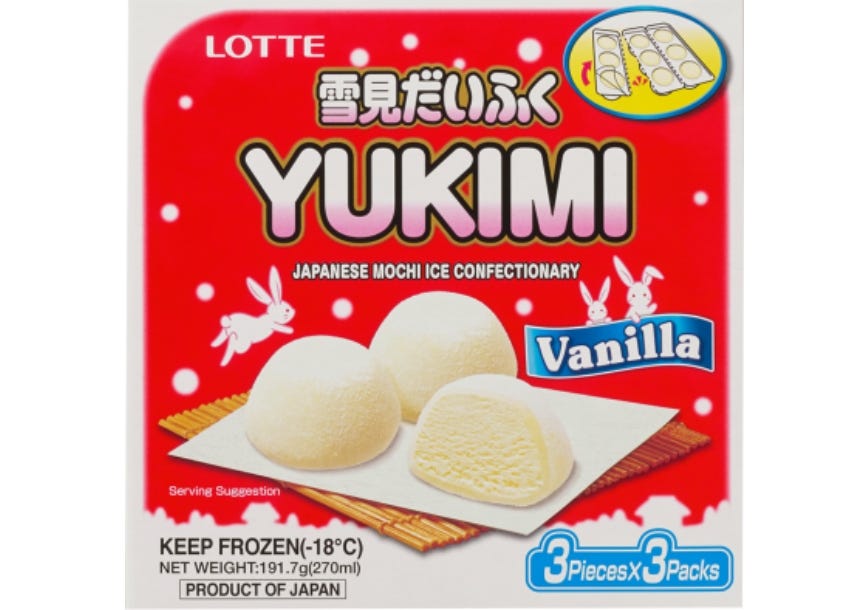Why beach kai is the best
On the joys of eating on the sand, NZ's booming nolo (no- or low-alc) drinks scene, and the perfect ice cream snack for a sweltering day.
Nau mai, haere mai. Welcome to The Boil Up, The Spinoff’s weekly food newsletter. This edition is by guest writer Lucinda Bennett (@lulu_baguettes). It’s lovely to have you here!
Kai, all on its own, is one of the best things, but isn’t it even better to eat it outside on a midsummer evening? In a garden or at a park, when it’s still light but the sun has lost all harshness and a soft breeze brings with it the scent of fresh dried laundry and tomato leaves. Or in the still-dark kitchen of the early morning, stealing spoonfuls of slightly melted leftover trifle straight from the fridge, the custard somehow sweeter than if you transferred it to a bowl.
I think the very best thing is when food and place combine to become another kind of experience. It is for this reason restaurateurs covet heritage buildings or open venues in the middle of beautiful nowhere, why they will spend thousands on custom lighting, hardwood furniture and fresh flowers. They understand that where we eat is almost as important as what we’re eating. Whenever I’m asked if I’ve eaten anything good lately, flavours always mingle with context.
A Fruju has never tasted so good as the one you slurped down in the back of the car, aircon broken and still an hour from the campground. Halftime at the rugby, optimistically joining the snaking line of sports fans, being rewarded with a hot, greasy bag of doughnuts drowning in cinnamon-scented sugar. A handful of scroggin and a swig of Raro to keep you going until the sweet cup of tea and squashed luncheon sandwich you get at the top of the maunga.
Possibly the best kai + context combination of all is the one that’s in season right now. Salt air, hot sand, the sound of waves crashing. A bundle wrapped in butcher’s paper under your arm, someone else is carrying the fizzy and a tin of tomato sauce. Everyone cheers when you arrive at the right cluster of towels, sandy fingers unwrapping the parcel, searching the sea of beige for their piece of tarakihi, potato fritter, battered oyster. There are no cups for the fizzy so you take turns swigging from the bottle. It’s good because it’s so easy, there’s always a shop nearby and everyone knows what’ll be on offer, but it’s the best because of something more elemental, eating hot and salty food when you’re hot and salty, eating fish with your skin still damp from swimming in their element.

But I don’t just mean fish and chips at the beach. I mean anything eaten at the beach. Last week I had just baked a plum torte in fig leaves (inspired by Natasha Pickowicz) when my group chat lit up: beach? I packed the still-warm torte in tupperware and headed to the ocean. My first beach day of the summer was impromptu, occurring only because my friends and I happened upon a local iwi fundraiser selling fresh ika, fry bread and hāngī still warm from the pit. We forfeited our hike and took our feast to the beach where the Northland sun gleamed down on our oily aluminium containers.
These examples of beach kai might be unconventional, but they are nothing compared to the impressive set-ups I have observed this summer. A whole fish cooking over a coal barbecue on the sand. A rice cooker simply unplugged and taken to the beach, sitting on a folding table next to so many containers filled with all manner of cooked meat and banchan.

While I love to see folks give new meaning to BYO, seeing the beaches so packed this summer has reminded me of the ones I visited in Europe. On OE in Barcelona, my sister and I showed up with nothing but our towels and were able to buy ice blocks out of a chilly bin from a man walking up and down the sand. Other vendors offered fresh fruit and cold drinks with people willing to pay a premium for the towel-side service. When we were ready for something more substantial, we wandered over to a kiosk for fried calamari. Wouldn’t it be glorious if we could import this culture to Aotearoa? As much as I love packing a Tupperware of leftover pizza in my beach bag, wouldn’t it also be great to rock up to the beach empty-handed and leave salty-haired and satiated?
Weekly bites
One of the reasons I may have observed such ingenuity at the beach this summer is because we are feeling the pinch. With food prices still sky high, takeaways on the sand are a luxury not everyone can afford. Despite last week’s report that December 2023 saw food prices increase at the slowest rate since December 2021, it looks like caution is still advisable with the atrocities ongoing in Gaza and Yemen disrupting trade routes – although if your biggest concern about these events is whether you’ll get your Easter eggs, you may need to examine your priorities.
Having personally spent the silly season teetotal as I recovered from a surgery, I can confidently state that the nolo (that’s no or low alcohol) scene in Aotearoa is booming – and we’re not alone. According to The Guardian, the trend towards alcohol-free and low-alcohol drinks is growing globally, with a recent report by hospitality research organisation KAM finding that 5.2 million fewer UK adults are drinking weekly in 2023 than they were just two years ago. For anyone looking to cut back or cut out, my personal favourite nolo choices are the brisk pét-nat ciders from Pōneke winemakers Fruit Cru (around 7% ABV), cans of Almighty sparkling water (especially the passionfruit ones) and any of the zero-alcohol wine alternatives from Australian company NON.
It was only a matter of time before someone capitalised on the cultural appetite for food content and made a TV show about restaurant kitchens – and I don’t mean Gordon Ramsay’s Kitchen Nightmares. For anyone who has watched The Bear, which is to say, probably everyone reading this newsletter, it will come as no surprise that the show was awarded 10 Emmys, having also just won three Golden Globes the week prior. If you haven’t watched, see here for the details on where to catch all the winning shows in New Zealand.
Snack of the week
Lotte Yukimi Japanese Mochi Frozen Dessert Vanilla, $7 for nine at Jadan Supermarket (but available at all the big ones). Haters will say ice cream is not a snack, but today it almost hit 30°C – what am I meant to do, eat chips? I would much rather lie on the sofa in my knickers with a fan on the highest setting directed straight at me, eating something cold, like dumpling-sized balls of ice cream cocooned in a thin, powdery blanket of mochi. For the uninitiated, mochi is a type of sticky rice cake traditionally eaten at Japanese New Year. I have been a mochi lover ever since I first bit into a daifuku – mochi with a sweet bean paste filling – that exactly resembled a peach, purchased by happy accident from an underground food market in Tokyo. There’s just something so satisfying about the smooth, elastic texture of mochi, perhaps because it is a perfect example of Q texture, a term used in Taiwan to describe foods with a soft, bouncy feel, like boba, noodles and fish balls. When Q gives way beneath your teeth to something cold, sweet and creamy, it’s even better, and that’s what biting into a Yukimi is like. Sure, the mochi layer is slightly denser and less bouncy than it could be (although a couple of minutes outside the freezer before you dig in does help) and the vanilla flavour is below Tip-Top in quality, but this is a mass-produced, pre-packaged gourmet treat you can pick up at your local Pak’n’Save! And in all honesty, the slightly faux quality is part of the allure—there is an almost futuristic quality to this unassuming little white ball which once bitten, reveals such contrasting textures and temperatures. All in all, the perfect treat for a disgustingly hot day. 9/10
Mā te wā,
Lucinda











